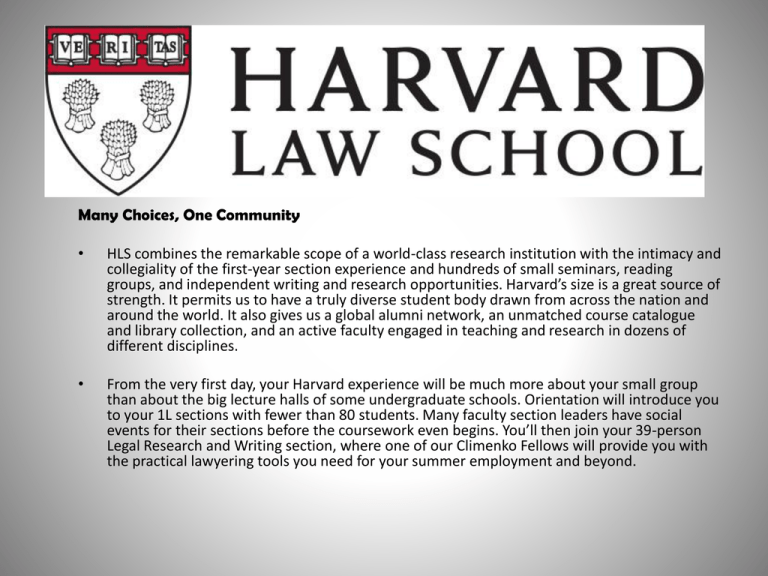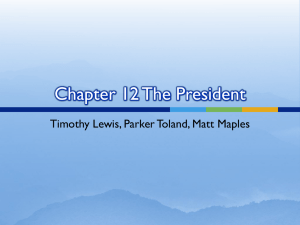Harvard Law Classes
advertisement

Many Choices, One Community • HLS combines the remarkable scope of a world-class research institution with the intimacy and collegiality of the first-year section experience and hundreds of small seminars, reading groups, and independent writing and research opportunities. Harvard’s size is a great source of strength. It permits us to have a truly diverse student body drawn from across the nation and around the world. It also gives us a global alumni network, an unmatched course catalogue and library collection, and an active faculty engaged in teaching and research in dozens of different disciplines. • From the very first day, your Harvard experience will be much more about your small group than about the big lecture halls of some undergraduate schools. Orientation will introduce you to your 1L sections with fewer than 80 students. Many faculty section leaders have social events for their sections before the coursework even begins. You’ll then join your 39-person Legal Research and Writing section, where one of our Climenko Fellows will provide you with the practical lawyering tools you need for your summer employment and beyond. Chapter 9 The Constitution: A More Perfect Union CONTSTITUTIONAL GOVERNMENT Course 512 • Three Branches of Government Rap • http://www.youtube.com/watch?v=ZCB8EOY5 d48 • School House Rock- Preamble • http://www.youtube.com/watch?v=30OyU4O 80i4 • School House Rock- 3 Branches of Government• http://www.youtube.com/watch?v=x5M50xBz 1cU 9.1 Introduction • Framers wanted to create a central government that would be strong and lasting but not so strong that it endangered citizens freedoms. • They wanted it to be simple and organized… • IT is divided into sections or articles. • Article I- Legislative Branch • Article II- Executive Branch • Article III- Judicial Branch • Article IV- Relations Among the States • Article V- Amending the Constitution • Article VI- National Supremacy • Article VII- Ratification of the Constitution • Bill of Rights (Amendments) 9.1 Introduction 9.1 Introduction • The Constitution is flexible and includes procedures for changing. • The Constitutions flexablity is its strength. 9.2 The Preamble • Explains the reasons for the new government. • Begins with famous words… “We the People…” • Popular Sovereigntygovernment's authority comes for the people. • 1. Establish Justice- rule by laws not by kings. • 2. Domestic Tranquilitypeace & order w/in the country. • 3. Provide for the Common Defense- protect against foreign enemies. • Promote General Welfaresupport economy & society. • Secure the Blessings of Liberty to ourselves and out Posterity.”- Protect the freedoms of generations of the future. 9.2 The Preamble 9.2 The Preamble • The framers want a strong central government…but are afraid b/c of their experience with kings. • But if the central government is to weak they are afraid b/c of their experience with Shays’ Rebellion & problems with the Articles of Confederation. • Must create a “balance” How are they going to create this “balance”? • School House Rock- I’m Just a Bill • http://www.youtube.com/watch?v=VxT7QjlvD qM 9.3 Legislative Branch • Article I of the the Constitution gives the power to make laws to the legislative branch. • 2 part Congress– House of Rep – Senate Capitol Building, Washington D.C. 9.3 Legislative Branch Senate House of Representative • 2 from each state- balance the large & small states. • Based on population- based on census taken every 10 years. (set at 435) • 6 year terms • 2 year terms • 30 years old • 25 years old • Citizen for 9 years • Citizen for 7 years • Elected by the people • Elected by the people. House of Rep. (435) 9.3 Legislative Branch Congress makes the Laws/Taxes. House of Rep Senate • New Taxes can only come from the house…if a majority approves goes to senate • Senate debates new taxes…if both approve the tax it goes to the pres. The Pres. Can approve or veto. The congress can over-ride the pres. …but must have 2/3 majority (super majority.) 9.3 Legislative Branch Congress makes the Laws/Taxes. House of Rep Senate • Any member can propose new law (called a bill.) Must be approved in both House & Senate. • Any member can propose new law (called a bill.) Must be approved in both House & Senate. The Pres. Can approve or veto. The congress can over-ride the pres. …but must have 2/3 majority (super majority.) 9.3 Legislative Branch Other Powers • Make the LAWS • Propose taxes & amendments to the Constitution. • Approves Presidential Appointments • Pay government debts • Decide how to spend tax money. • Grant citizenship. • Approve funds for laws and programs • Est. Federal courts • Approve treaties • Elastic clause- can make any laws that seem necessary to carry out powers. • Declare war • Raise army or navy. • Impeachment • School House Rock- Electoral College• http://www.youtube.com/watch?v=oyIFqf3XH 24 9.4 Executive Branch • Article II gives the power to enforce or execute the laws to the chief executive… • the Pres. • The Pres is elected by the electoral college. 9.4 Executive Branch • The electoral college is based on population. • House of Rep + Senators = number of Elector college. • Pres must win a majority of the electoral college. • (magic no. 270 Electoral Votes) % % Simple Majority • House of Rep + Senator = # of Electoral college. Mississippi • 2 Senators + 4 Representatives in the House= 6 Total Electoral College Map 2012 Qualifications To Be Pres. • 4 year term • Can only serve 2 terms • At 35 years old • Must be natural born citizen • Natural born citizen- born in the U.S. or born out the U.S. but one or both parents are U.S. Citizens that have lived in the U.S. Powers • Enforce laws & defend constitution • Commander of armed forces. • Make treaties & formal agreements w/consent from senate • Nominates ambassadors, supreme court judges • Veto • Grant pardons Departments • Pres. has special departments to help him manage all his responsibilities. • For Example– State Department – Justice Department – Department of Health The Head of Each Department makes up the Cabinet. How many cabinet members? 15 http://answers.yahoo.com/question/index?qid=20070102215111AAGgu58 Impeachment/Removing the Pres. • The Pres. is not above the law. • The House of Rep. can vote to impeach. • The Senate puts the President on trial..the Senators serve as the jury. 2/3 (Supermajority) • 2/3 majority of the Senate to remove Removing the Pres. • Can be removed for “bribery, treason, or other ‘high crimes’”. • Andrew Johnson 1868-Tenure of Office Act. • Bill Clinton 1998- Lying to Grand Jury. • (Nixon ‘73 & ‘74)- Watergate 2/3 (Supermajority) 9.5 Judicial Branch • Article III- gives the power to judge the laws to the judicial branch • They have to judge/interpret wither laws & actions of the government are in conflict with the Constitution. Supreme Court, Washington D.C. Powers • Judge & Interpret Laws • Review Lower-court decisions • Judges whether laws and executive actions are constitutional • Rules on cases between states. There are 2 lower courts. – District – Appellate (appeal) – District Courts cover several states. – If you want a decision appealed you go to appellate court…you want to go higher after that you go to Supreme Court. Lower or Inferior Federal Courts The Last Stop • The Supreme Court is the last stop…all decisions are final. • Congress has set the size at 9. • Justices usually serve for life…but can be removed The Last Stop • Lawyers ask the Supreme Court to review thousands of cases, but they usually on consider about 100. • And only if they think a lower court decision conflicts with the Constitution or a federal law. • Roe vs. Wade Famous Supreme Court Decisions • Miranda vs. Arizona • Brown vs. Board of Education of Topeka • Dred Scott vs. John F.A. Sandford • Engel v. Vitale (1962) Roe vs. Wade Keeps Congress & the Pres. In Check • Judicial Review- the power of the Supreme Court to decide whether laws and acts made by the legislative & executive branches are unconstitutional. 9.6 Checks & Balances Between the Branches • The Framers were concerned about the balance between strong national government and individual freedoms. • They developed a system of Checks & Balances. 9.6 Checks & Balances Between the Branches • This system allows one branch to check or block the actions of another branch. • These checks and balances keep any one branch of the federal government form being to strong. • It is one of the most important features of the U.S. government system. 9.7 The Amendment Process • The framers knew that the Constitution would need changing over time… • The made it changeable but very difficult. • Article V- describes changes can be made 9.7 The Amendment Process 1. Congress may propose a change (2/3 vote from both houses)… • or 2. Congress can call a National Convention if 2/3 of states legislatures want a change. But wait…there’s more! Must be ratified (approved) • 1. may be approved by the legislatures in ¾ of the states… • Or • 2. by special conventions in ¾ of the states. But wait…there’s more! No Just Kidding.. that’s it. • Then it can become a part of the Constitution. • More that 10,000 amendments to the Constitution have been proposed over the years. • Only 27 have been approved. • The first 10 (Bill of Rights) • Plus 17 one-at-a-time Amendments that have been added that you need to have memorized… 13th- Slavery is illegal. 19th- Women’s Suffrage (Vote) 26th- all citizens over 18 have the right to vote. 9.8 The Federal System Federalism: • The framers wanted to establish a strong national government where states are still able to keep significant powers. • (Shared Powers) Commerce Clause • The National Government has the power to regulate interstate commerce. • The U.S. is a freetrade zone between states. Review- The Preamble • “We the People..” • Popular Sovereigntyauthority comes directly form the people. Review- The legislative Branch • Article I of the Constitution creates a bicameral Congress with a House of Representatives and a Senate. • Every state is represented by two senators. • Representation in the House is based on a state’s population. • Congress’s primary ob is to make laws. Review- Executive Branch • Article II creates a the executive branch. • The head of the executive branch is the president. • The presidents serves a four-year term and may be reelected once. • The president carries out laws passed by Congress. • Other powers of the president include making treaties and appointing Supreme Court justices. Review- Judicial Branch • Article III establishes the Supreme Court and gives Congress the power to create lower courts. • Supreme Court decisions are binding on all lower courts. • The power of judicial review allows the Supreme Court to decide whether laws and actions by the legislative and executive branches are unconstitutional. Review- Checks and Balances • The framers developed a system of checks and balances that enables each branch of government to limit, or check, the power of the other two branches. • The Constitution provides checks and balances in the powers of each branch. Review- The Amendment Process • Article V outlines the process by which amendments can be made to the Constitution. • Twenty-seven amendments have been added. • The first ten amendments form the Bill of Rights. Review- The Federal System • The Constitution creates a federal system of government in which power is shared between the national government and the states.







